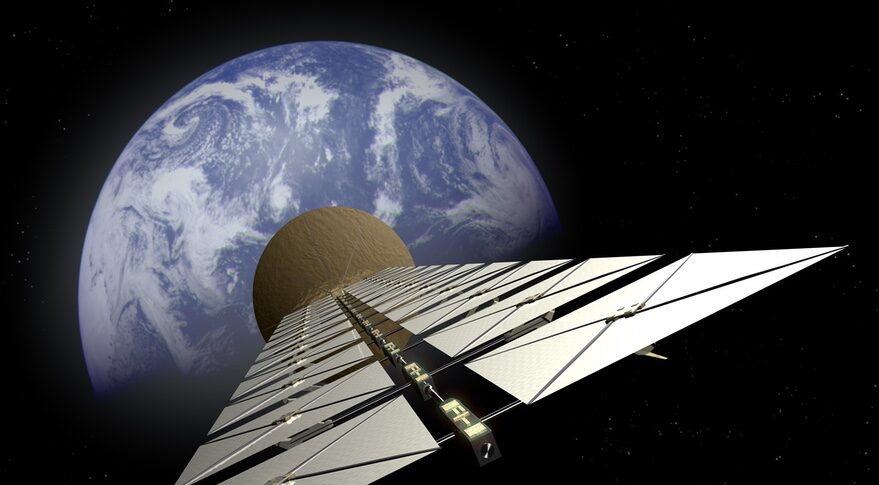Concepts for beaming solar energy from satellites to Earth via radio waves aim to revolutionize the market for clean and sustainable power.
If successful, they would open up the colossal energy industry to the space sector while potentially helping connect around 700 million people estimated to be without access to electricity.
But while space-based solar power (SBSP) principles have been around for decades, the economics for power plants that would need to span thousands of kilometers in orbit have not added up.
That could now be changing with the advent of renewable rockets and advancing in-orbit assembly capabilities.
The latest SBSP concepts also envisage modular structures in geostationary orbit (GEO) ranging from about two million to 10 million kilograms.
While still enormous, the original NASA Solar Power Satellite reference system from the late 1970s was not modular and had a proposed mass of about 50 million kilograms. That’s over seven thousand times more mass than the heaviest commercial satellite ever launched to GEO.
According to a study by engineering firm Frazer Nash Consultancy for the British government last year, SBSP is now not only technically feasible but it could also be developed quickly enough to significantly contribute to the U.K.’s goal to decarbonize its economy by 2050.
In July, the U.K. announced an SBSP Innovation program that will provide an initial £3 million ($3.6 million) in grants toward system studies and de-risking core technology.
However, aside from the technical challenges, this emerging capability also needs to clear multiple regulatory hurdles.
One of the biggest is identifying the best way to regulate power-beaming radio spectrum for tests, let alone commercial operations that could last decades, says John Worthy, a partner at law firm Fieldfisher.
Worthy heads Fieldfisher’s satellite and space projects and leads a legal and regulatory working group for the U.K.- based Space Energy Initiative (SEI), an organization of academic, government and commercial members seeking to develop the first orbital SBSP demonstrator.
“This is forging into new territory in regulation, and we are working with regulators to find the most effective and efficient pathway,” Worthy said.
Current international space treaties also did not foresee in-orbit assembly and servicing needs when they were signed in the 1960s and 1970s.
Worthy said the industry “needs a framework to govern how the components of a satellite are delivered into orbit” and then boosted to GEO to be “assembled into the complete working satellite.”
Assembling a solar plant in space would also require many launches. As broadband megaconstellations also add to the launch tally, Worthy said regulation on managing space debris and decommissioning satellites after they have run out of fuel needs to be clarified to ensure safe operations.
More regulatory clarity could also help attract investors.
The SEI-backed Space Solar Limited startup is looking to raise around $300 million for the first phase in its roadmap toward an operational system in 12 years.
Martin Soltau, Frazer Nash Consultancy’s head of space and co-chair of SEI, said phase one would see the venture develop the system’s design and de-risk many of its elements.
“We will prototype the power and solar collection modules and demonstrate the wireless power beaming and robotic assembly concepts in laboratory and field trials,” Soltau said.
Its design will use a concept that can work on a smaller scale in lower elliptical orbits. Soltau said this provides a pathway of demonstrator stepping stones toward a two million kilogram satellite with a diameter of 1.7 kilometers in GEO.
“Within six years we will be beaming Megawatts of power, enough to power a village, at a representative power density,” Soltau said via email, “and at this point the UK Government has confirmed that it will establish SBSP in energy policy.”
But while he said the core wireless power beaming technology is already well understood, autonomous capabilities for assembling large structures in orbit remain immature.
“This however is advancing very rapidly with a number of space logistics companies already demonstrating relevant technologies in space,” he added, such as Northrop Grumman with its Mission Extension Vehicle for refueling satellites.
And much like how international coordination of radio frequencies for communications has been a cornerstone for the growth of connectivity and observation satellites, Worthy sees a major opportunity for SBSP if the same is achieved for power transmission.
Standards “for wireless power transmission, in orbit assembly and managing space debris and decommissioning will help to unlock the potential of this new source of renewable energy,” he added.
This article originally appeared in the August 2022 issue of SpaceNews magazine.

